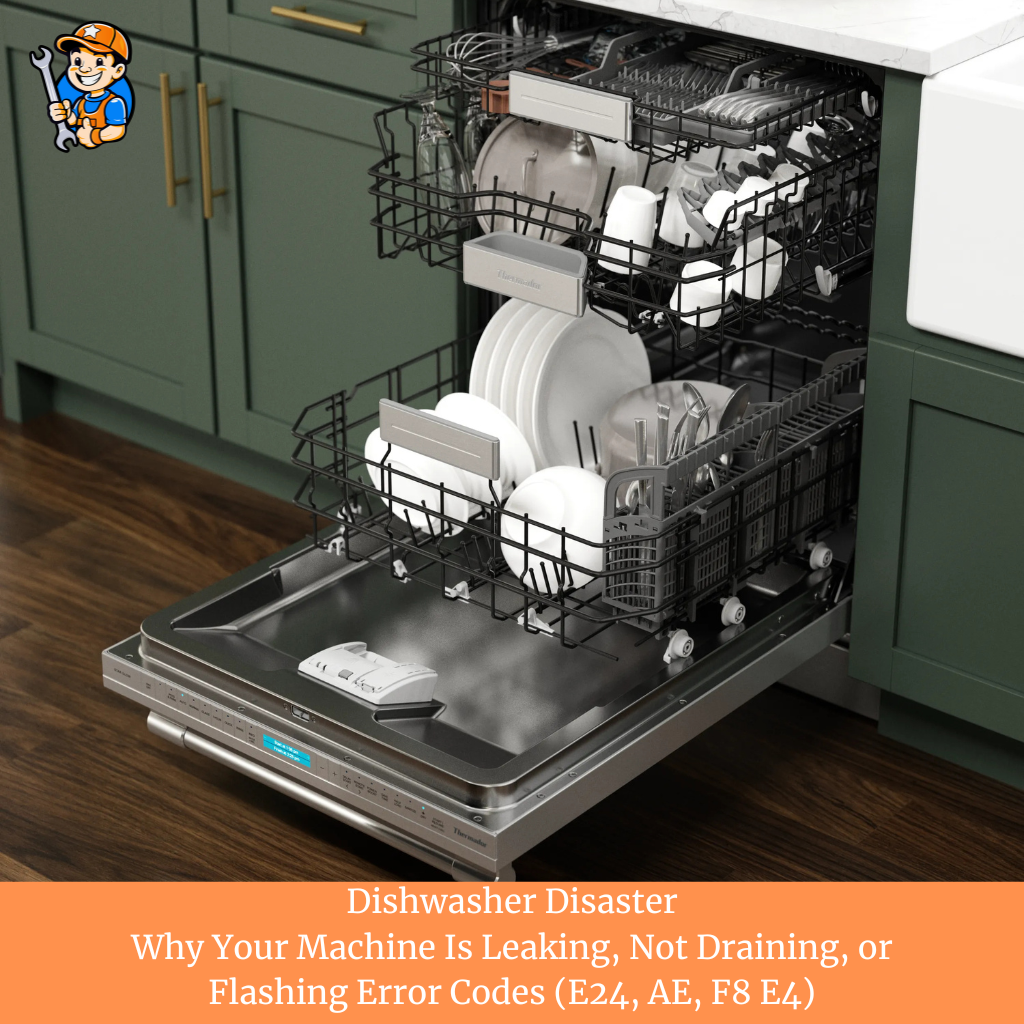Dishwasher Disaster: Why Your Machine Is Leaking, Not Draining, or Flashing Error Codes (E24, AE, F8 E4)

There are few things more disheartening than opening your dishwasher after a cycle to find a puddle on the floor, a pool of dirty water in the bottom, or a confusing error code flashing on the screen. A malfunctioning dishwasher can bring your kitchen routine to a screeching halt, leaving you to face a sink full of dirty dishes.
At Star Appliance Repair, we know how essential a working dishwasher is for your home. We offer reliable, in-home dishwasher repair Toronto and across the Greater Toronto Area (GTA), getting your kitchen back to its clean and efficient self. Before you panic, let’s explore the common reasons your dishwasher might be acting up and what those cryptic error codes mean.
Leaking: A Sign of a Deeper Problem
A dishwasher leak is more than just an annoyance; it can cause serious water damage to your floors and cabinets. Leaks often have a clear cause:
- Faulty Door Seal: The rubber gasket or seal around the dishwasher door is designed to prevent water from escaping. Over time, it can crack, tear, or become brittle, leading to leaks. A quick inspection might reveal a visible tear.
- Clogged Drain Hose: If the drain hose is blocked with food particles, a piece of glass, or other debris, water can back up into the machine. This can cause the dishwasher to overflow, and the excess water may leak out from the front door or the bottom of the unit.
- Loose or Damaged Hoses: The hoses that supply water to the dishwasher and drain it away can become loose, crack, or get a small hole. This is a common source of leaks, especially if the water is coming from underneath the appliance.
- Too Many Suds: Using too much dish soap or the wrong type of detergent can cause an excessive amount of suds. These suds can leak out of the machine and create a puddle on your floor. Always use detergent specifically designed for dishwashers.
Not Draining? The Clog is Probably the Culprit
A dishwasher that won’t drain is a sure sign of a blockage. Your machine needs a clear path to get rid of the dirty water.
- Clogged Filter: The filter at the bottom of the dishwasher is designed to catch food particles and debris. If it’s not cleaned regularly, it can become completely blocked, preventing water from draining out.
- Blocked Air Gap or Drain Hose: The air gap (a small cylinder usually on top of your sink) and the drain hose can both get clogged with food and grease. A blockage here prevents water from being properly pumped out of the machine.
- Faulty Drain Pump: The drain pump is a motor that actively pushes water out of the dishwasher and into the drain line. If the pump is broken, burned out, or has something stuck in its impeller, it won’t be able to do its job.
Decoding Common Dishwasher Error Codes
Modern dishwashers use a series of codes to communicate exactly what is wrong. While they might look like gibberish, they’re your best diagnostic tool.
- E24 or F8 E4 (Bosch): This is a very common Bosch error code that means water is not draining. It’s a classic sign of a clogged drain hose, a blocked filter, or a faulty drain pump.
- AE (LG): This code stands for Aqua-Stop Error. It indicates that the machine has detected a leak and has activated its flood protection system to shut off the water supply. It’s an important warning that you have a leak.
- F8 E1 (Whirlpool): This code means the water valve is overflowing. It could be a sign that the float switch is stuck or that the water inlet valve is faulty, allowing too much water into the tub. This can also lead to draining and leaking issues.
- Ld (Samsung): The leakage detected code. Similar to LG’s AE, this code means the dishwasher has found water where it shouldn’t be, triggering its safety shut-off.
Can You Fix Your Dishwasher Yourself?
Some simple troubleshooting can be done at home. You can:
- Check for a Tripped Breaker: Sometimes, a simple circuit breaker reset can solve the problem.
- Clean the Filter: Locate the filter at the bottom of the tub. Remove it and rinse it thoroughly to clear any food particles.
- Inspect the Door Seal: Look for visible cracks or tears in the seal and wipe it down with a damp cloth to remove any debris.
- Check the Drain Hose for Kinks: Make sure the hose behind the machine is not bent or crushed.
If these simple steps don’t fix the issue, a professional is your best bet. Dealing with internal components like the drain pump or water valves can be complex and risky.
Don’t let a leaky or clogged dishwasher ruin your day. If you’re experiencing a problem, contact the experts at Star Appliance Repair. We’ll get your machine running smoothly again.
To book your service, fill out our online form or call us at (647)-847-8774 for expert dishwasher repair Toronto and the GTA.
appliance repair North York, appliance repair Vaughan, dishwasher repair Mississauga

